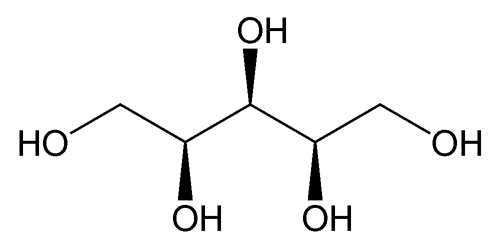Xylitol
(zye' li tol).
DEFINITION
Xylitol contains NLT 98.5% and NMT 101.0% of C5H12O5, calculated on the anhydrous basis.
IDENTIFICATION
• A. Infrared Absorption  197K
197K (undried sample)
(undried sample)
ASSAY
• Procedure
Internal standard solution:
3.5 mg/mL of USP Erythritol RS
Standard solution:
0.05 mg/mL each of USP l-Arabinitol RS, USP Galactitol RS, USP Mannitol RS, and USP Sorbitol RS, and 10 mg/mL of USP Xylitol RS
Sample solution:
10 mg/mL of Xylitol
Chromatographic system
Mode:
GC
Detector:
Flame ionization
Column:
0.25-mm × 30-m capillary column bonded with a 0.25-µm layer of phase G46
Temperature
Injector:
270
Detector:
280
Column:
See Table 1.
Table 1
| Initial Temperature ( |
Temperature Ramp ( |
Final Temperature ( |
Hold Time at Final Temperature (min) |
|---|---|---|---|
| 170 | — | 170 | 5 |
| 170 | 6 | 215 | 8 |
| 215 | 10 | 270 | 14 |
Carrier gas:
Helium
Flow rate:
1 mL/min
Injection size:
1 µL
System suitability
Sample:
Standard solution
[Note—The relative retention times corresponding to the derivatives of erythritol, l-arabinitol, xylitol, mannitol, galactitol, and sorbitol are 0.47, 0.75, 0.81, 0.98, 0.99, and 1.0, respectively. ]
Suitability requirements
Relative standard deviation:
NMT 1.5% for the peak area ratios of xylitol to erythritol
Analysis
Samples:
Standard solution and Sample solution
Transfer 1.0 mL each of the Samples to separate round-bottom, 10-mL boiling flasks. To each flask, add 1.0 mL of Internal standard solution, and evaporate each of the mixtures under reduced pressure to dryness on a water bath at 60 , with the aid of a rotary evaporator. Add 1 mL of dehydrated alcohol, shake gently, and evaporate to dryness under the same conditions. Dissolve each residue in 1 mL of pyridine. Add 1 mL of acetic anhydride to each flask, cap each flask, and mix on a vortex mixer for 30 s. Store the closed flasks in an oven at 70
, with the aid of a rotary evaporator. Add 1 mL of dehydrated alcohol, shake gently, and evaporate to dryness under the same conditions. Dissolve each residue in 1 mL of pyridine. Add 1 mL of acetic anhydride to each flask, cap each flask, and mix on a vortex mixer for 30 s. Store the closed flasks in an oven at 70 for 30 min. Separately inject the solutions of the Sample solution and the Standard solution into the chromatograph.
for 30 min. Separately inject the solutions of the Sample solution and the Standard solution into the chromatograph.
Calculate the percentage of xylitol (C5H12O5) in the portion of Xylitol taken:
Result = (RU/RS) × (CS/CU) × 100
| RU | = | = peak area ratio of derivatized xylitol to derivatized erythritol in the Sample solution |
| RS | = | = peak area ratio of derivatized xylitol to derivatized erythritol in the Standard solution |
| CS | = | = concentration of xylitol in the Standard solution (mg/mL) |
| CU | = | = concentration of Xylitol in the Sample solution (mg/mL) |
Acceptance criteria:
98.5%–101.0% on the anhydrous basis
IMPURITIES
• Residue on Ignition  281
281 :
NMT 0.5%
:
NMT 0.5%
• Heavy Metals  231
231 :
NMT 10 ppm: using 2 g of Xylitol dissolved in 25 mL of water
:
NMT 10 ppm: using 2 g of Xylitol dissolved in 25 mL of water
• Reducing Sugars
Sample:
500 mg
Analysis:
Dissolve the Sample in 2.0 mL of water in a 10-mL conical flask. Into a similar flask, pipet 2 mL of a 0.5 mg/mL dextrose solution. To each flask, add 1 mL of alkaline cupric tartrate TS, heat to boiling, and cool.
Acceptance criteria:
Any turbidity in the xylitol flask is NMT that in the dextrose flask, in which a reddish brown precipitate forms (0.2% reducing sugars, as dextrose).
• Limit of Other Polyols
Analysis:
Using the chromatograms obtained in the Assay, separately calculate the percentage of each polyol in the portion of Xylitol taken:
Result = (RU/RS) × (CS/CU) × 100
| RU | = | = peak response ratio of the individual derivatized polyol to the derivatized erythritol in the Sample solution |
| RS | = | = peak response ratio of the individual derivatized polyol to the derivatized erythritol in the Standard solution |
| CS | = | = concentration of the individual polyol in the Standard solution (mg/mL) |
| CU | = | = concentration of Xylitol in the Sample solution (mg/mL) |
Acceptance criteria:
The sum of the polyols is NMT 2.0%, calculated on the anhydrous basis.
SPECIFIC TESTS
• Water Determination, Method I  921
921 :
NMT 0.5%
:
NMT 0.5%
ADDITIONAL REQUIREMENTS
• Packaging and Storage:
Preserve in well-closed containers.
Auxiliary Information—
Please check for your question in the FAQs before contacting USP.
| Topic/Question | Contact | Expert Committee |
|---|---|---|
| Monograph | Robert H. Lafaver, M.S.
Scientific Liaison 1-301-816-8335 |
(EXC2010) Monographs - Excipients |
| Reference Standards | RS Technical Services 1-301-816-8129 rstech@usp.org |
USP35–NF30 Page 2018
Pharmacopeial Forum: Volume No. 37(4)

